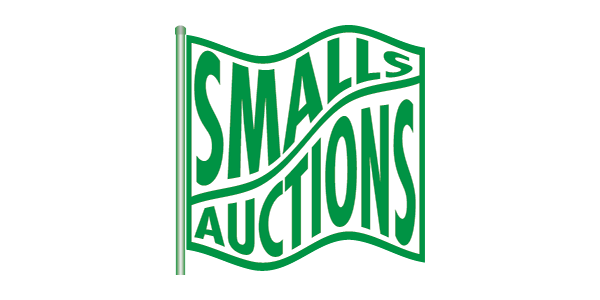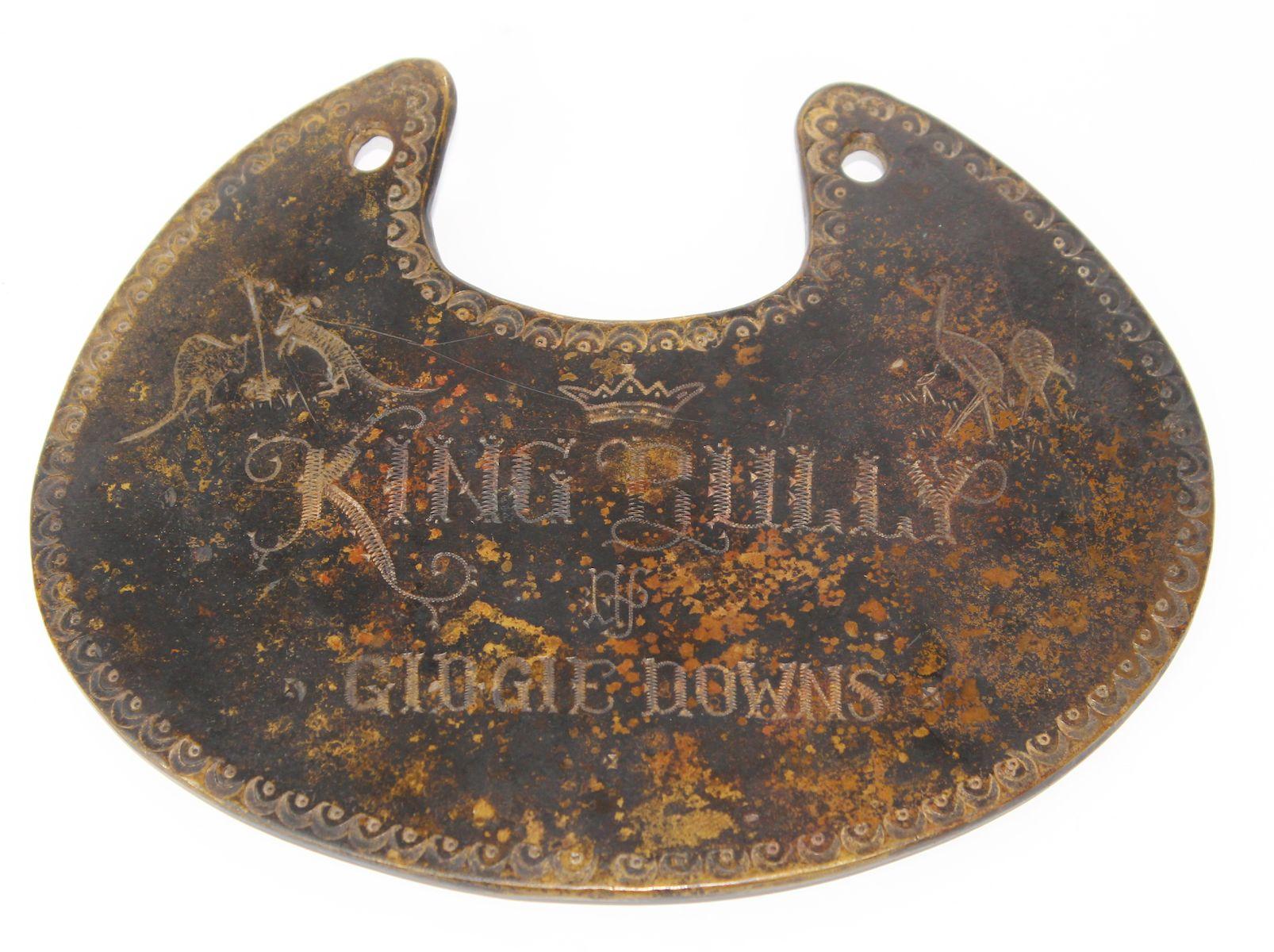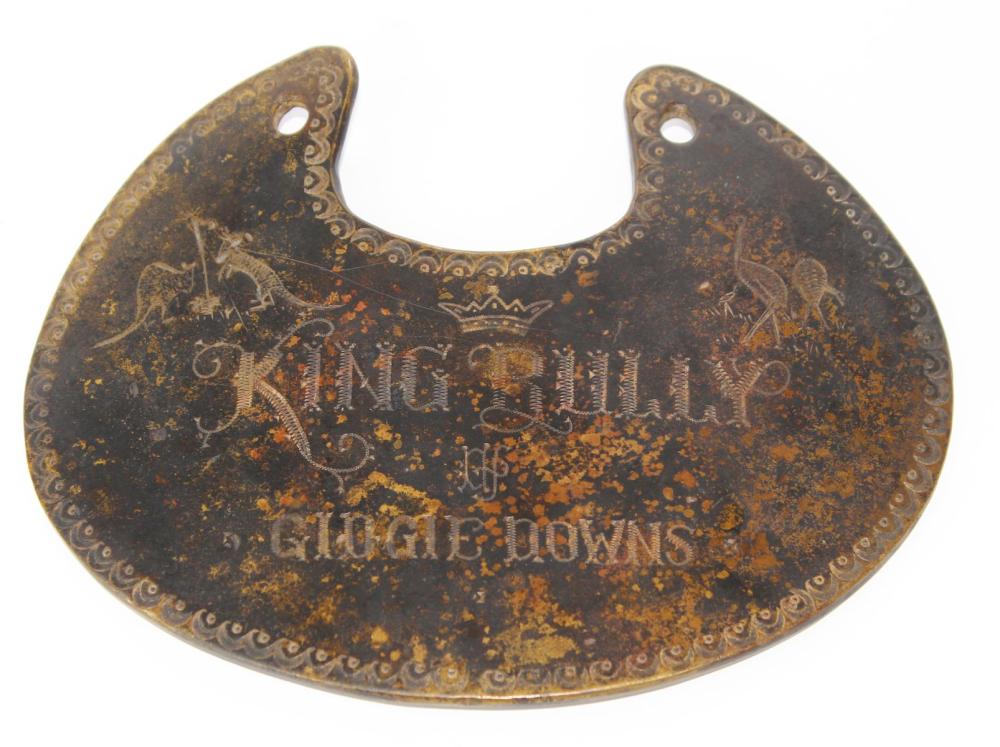Lot 53


Inscribed 'King Bully (sic) / of / Gidgie (sic) Downs.' Gidgee Downs Homestead is near Brewarrina in North-western New South Wales
-
Provenance:
- Ex Roy Hinz Collection Dimensions:
- Dimensions 16.5x8.5cms : Weight 387gms Exhibited:
- 919 Literature:
- Decorative Art Medium:
- Ethnographic & Indigenous Artifacts Circa:
- Australiana Notes:
- Kingplates or Breastplates are seen by many as an indignant reminder of the ill-treatment of Aborigines in Colonial Australia, but contrarily they are also seen by some historians as important relics of the white settlers interactions with the native inhabitants. The first Kingplates were distributed by Governor Macquarie to Aboriginal leaders who were elevated to 'King' status and were tasked with negotiating with the Government on behalf of all their tribe. Of course, there were no Kings or Queens in the native populations, so the arbitrary appointment of a 'King' overrode the democratic communal processes that traditionally underpinned Indigenous decision-making. The early plates were sand-cast and were loosely based on the Regimental Gorgets worn by Officers of His Majesty's Military and, whereas the Military Gorgets bore the Royal Cipher of the reigning King, the early Breastplates often bore a crude Ducal Crown which alluded to the official imprimatur assigned to the recipient. Over time large Station Holders adopted the practice of recognising a 'King of the Tribe' with whom they would negotiate, and a brass plate bearing their title was callously strung from a chain around their neck. From around the 1840s the plates were made of thin pressed brass often carrying the name of the Station or Homestead and, in this form, they continued to be used right up until the 1930s. In our Sale we have the Kingplate from the Gidgee Downs Homestead presented to King Billy which appears as No.52 in 'Poignant Regalia,' the 1993-4 Exhibition of 19th Century Kingplates curated by the Historic Houses Trust of New South Wales. The familiar 'Kangaroo' and 'Emu' motifs flank the plate although the posterior views of the native fauna are amusing if not unique. This plate is important for a number of reasons: Firstly, it seems to have escaped the notice of the cataloguers through the years that it is actually inscribed 'King Bully' and not 'King Billy' and that 'Gidgee' is spelt 'Gidgie.' Secondly, it has a unique set of hallmarks on the reverse side in the form of a monogram which appears to read 'CT' followed by 'N.S.W.' '84.' You would naturally assume that the '84' indicates that the plate was made in '1884' but, it has the heft and look of a much earlier piece. It is interesting that the hallmarks crudely follow the format found on fine Russian Silver where the solitary '84' Zolotniks stamp (87.5% pure) is accompanied by a location mark and maker's mark much like the monogram on this plate which could be mistaken at first glance for Cyrillic script. Was the plate the work of a Russian émigré who, proud of the finished product, used the punches available in his jewellery workshop to brand his craftsmanship? This theory might also account for the misspelling of Gidgee and the more obvious mistake of engraving 'Bully' instead of 'Billy' by someone not fully versed in the local vernacular. And thirdly, it mimics the earlier Macquarie-era plates with a Ducal Crown at the top of the design which again points to an earlier date of manufacture. It is highly unlikely that the use of the Crown device found on some early sand-cast examples would suddenly re-emerge in 1884 decades after its last use. The Gidgie (sic) Plate has plenty of unique attributes that make it important and ripe for further research. Kingplates are certainly tainted by their history which cannot be rewritten and so it is up to the individual to decide whether they see Kingplates as derogatory symbols of British Colonialism or rare relics of Australian Indigenous History.
Accepted Forms of Payment:
American Express, MasterCard, Money Order / Cashiers Check, Other, Paypal, Visa, Wire Transfer
Shipping
AUSTRALIA: Purchases within Australia will be charged a MINIMUM SHIPPING FEE of $5.50 and will be sent by Registered Post. Additional insurance is optional at the buyer's expense.
INTERNATIONAL: Overseas purchases will be charged a MINIMUM SHIPPING FEE of $20.00 and will be sent by Registered Post International. Additional insurance is optional at the buyer's expense.
Both Australian and International packages are traceable in transit and require a signature on delivery.
Smalls Auctions
You agree to pay a buyer's premium of up to 20% and any applicable taxes and shipping.
View full terms and conditions
| From: | To: | Increments: |
|---|---|---|
| A$0 | A$249 | A$5 |
| A$250 | A$999 | A$10 |
| A$1,000 | A$4,999 | A$25 |
| A$5,000 | A$9,999 | A$50 |
| A$10,000 + | A$100 |






